Nvidia GeForce GTX 1080 Ti 11GB Graphics Card Review
Peter Donnell / 7 years ago
Introduction

The power race is about to kick up yet another gear this week, as Nvidia prepare to launch their new flagship consumer gaming graphics card; the GeForce GTX 1080 Ti. The new high-end card features the GP102 GPU used in the Titan X, delivering a staggering 3584 CUDA cores, 224 Texture Units, a 352-bit memory controller, and a massive 11GB of GDDR5X memory. The boost clock is more than 85% higher than that of the GTX 980, and while it’s a few years old, the 980 is hardly a slouch in gaming tasks. It’s also clocked to deliver around 35% performance improvement over the GTX 1080, the biggest boost for any Ti series card to date! So we’re expecting nothing short of exceptional performance from this graphics card.

The card may look like the current GTX 1080, but the internal hardware is quite the step up. The card can boost up to 1582 MHz and even has more overclocking potential above that, said to be able to reach around 2GHz with the right cooling. The higher clocks are likely made possible by the new and improved cooler too, it may look the same, but this time it packs a new vapour chamber design. Overall, the card is expected to reach a 35% improvement over the performance of the GTX 1080.
Hardware Overview
- 12B Transistors
- 1.6 GHz Boost, 2 GHz OC
- 28 SMs, 128 Cores Each
- 3584 CUDA Cores
- 28 Geometry Units
- 224 Texture Units
- 6 GPCs
- 88 ROP Units
- 352 bit GDDR5x

“The GeForce GTX 1080 Ti, delivers even more performance than the TITAN X– it’s the ultimate gamer GPU! Gamers who want the very best performance for the latest DirectX 12 and Virtual Reality games will love the new GeForce GTX 1080 Ti.” – Nvidia
Packaging and Accessories
The box for the GTX 1080 Ti is beautifully designed and compact too, much smaller that most of the graphics cards that we usually see. It’s a simple design, but the box feels pretty durable overall.
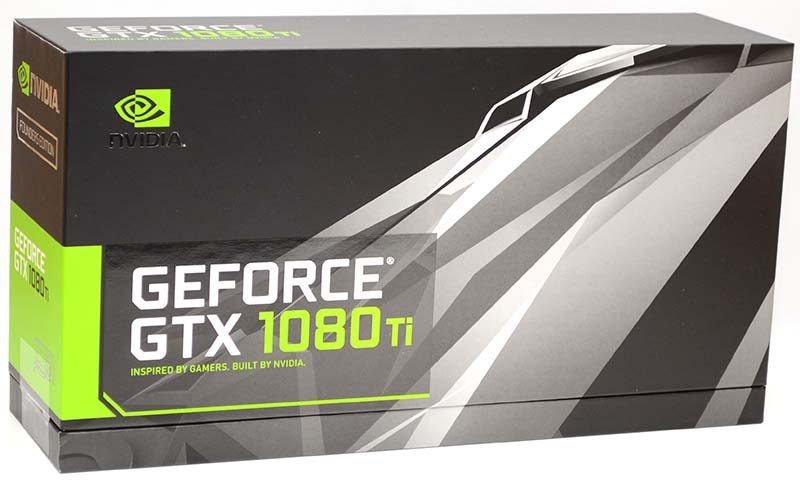
The lid lifts off the top, revealing the card protected by a layer of thick foam padding. We took off the anti-static bag already, but you get the idea.
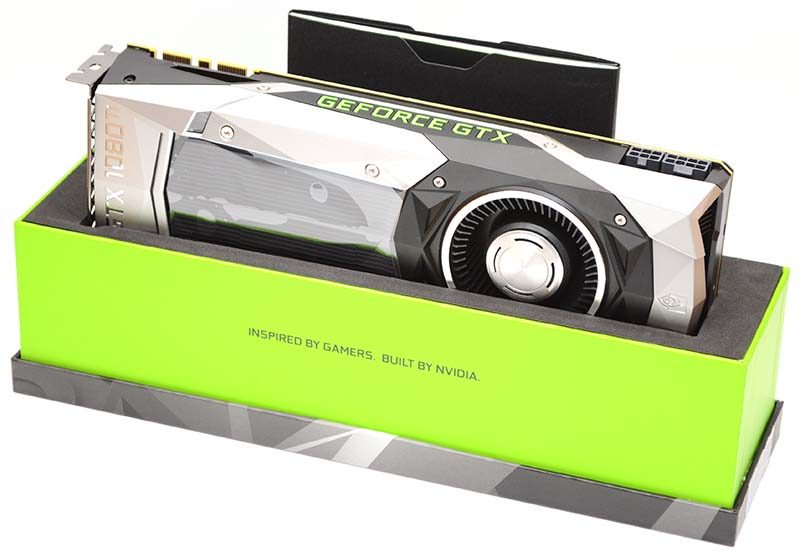
There’s not an enormous amount in the box, just the usual documentation, but it’s all very nicely presented.
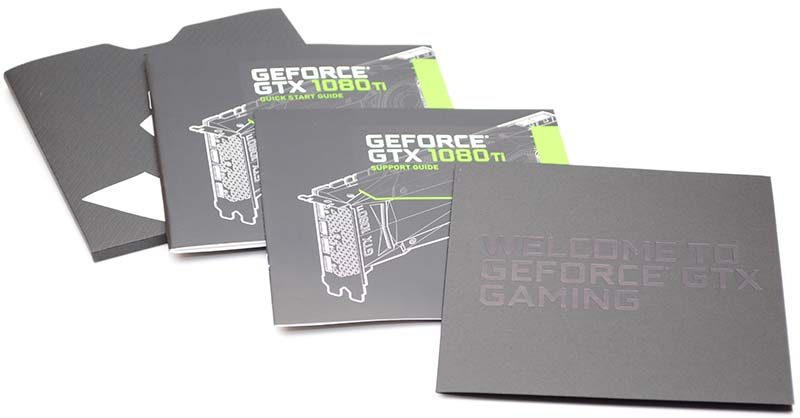
Finally, you’ll find the GPU itself, as well as a DP to DVI adaptor cable. That’s the basics covered, let’s take a closer look at this card, as I’m sure you’re all eager to see the features and performance in greater detail.
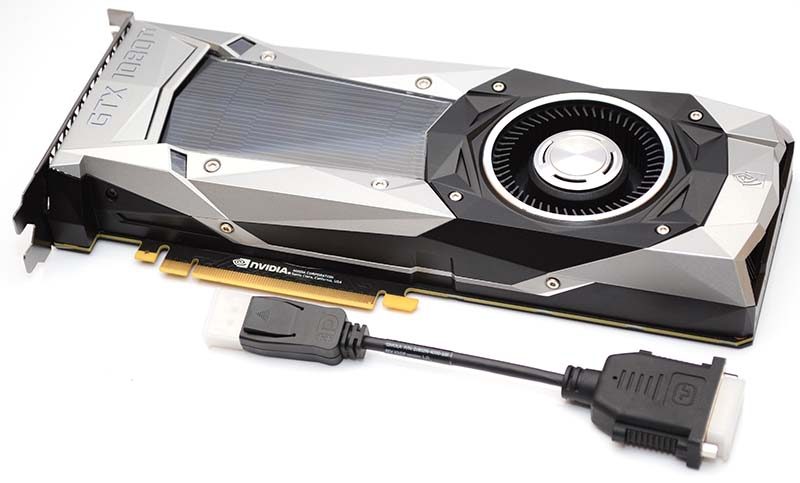
A Closer Look
The card features a design that should be more than familiar to Nvidia fans, with the angular and rather aggressive looking cooler and shroud design. It is a blower type card, which we’re not typically interested in, but we’re sure partner cards will be along soon enough with aftermarket cooler designs. However, the blowers that Nvidia use are are usually excellent in terms of thermal and acoustic performance.
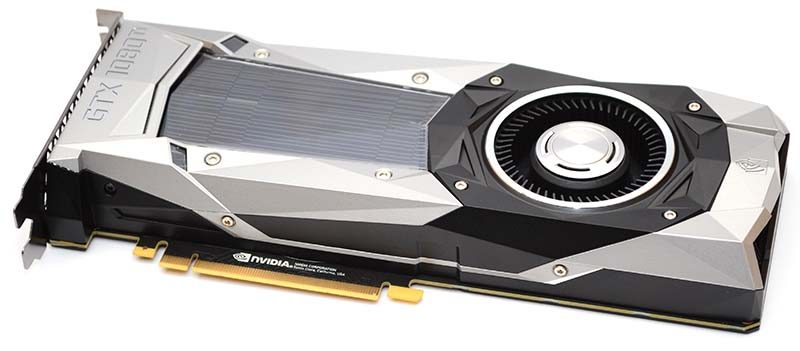
Down the other side, you’ll find two power connectors; 1 x 8-pin and 1 x 6-pin, as this card has a TDP of 250 Watts, and a recommended PSU rating of 600W, so it’s quite thirsty, but still pretty efficient at the same time.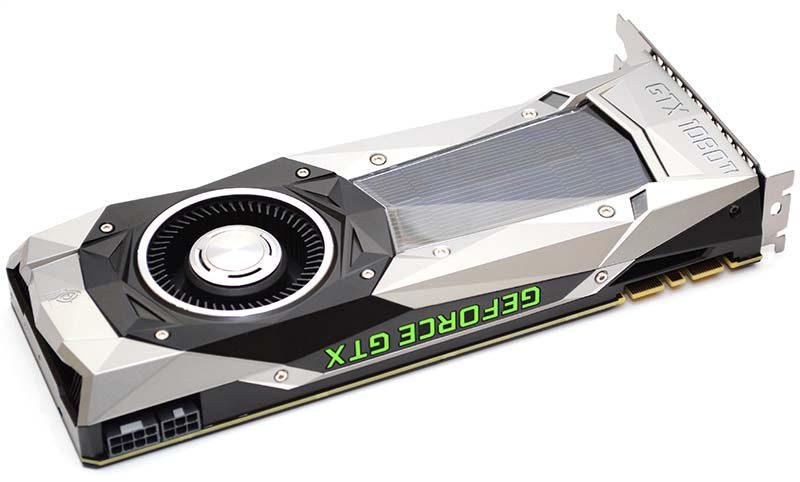
At the front of the card, you can see some of the fins for the heatsink which cover the card, and also forms part of the air in/out design for the blower fan.
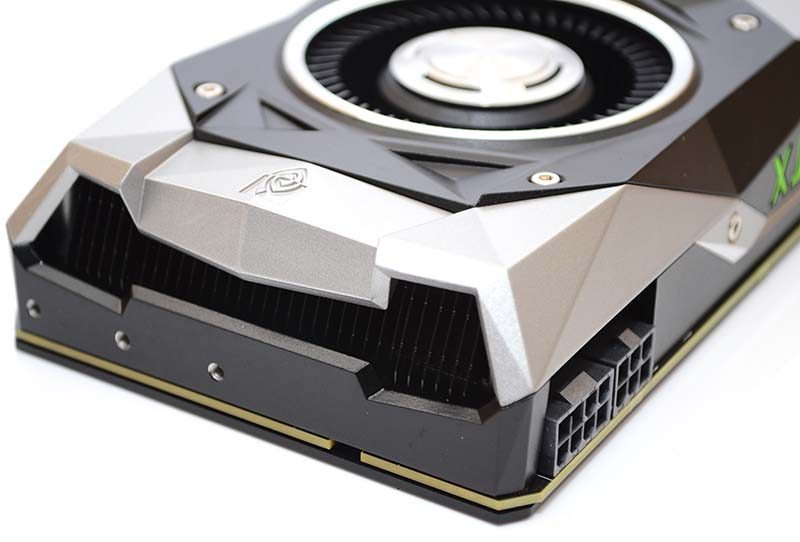
Around the back, a durable plate design with plenty of ventilation. The connectivity is good too, with three full-size DP ports, and an HDMI 2.0 port, so you’ll have no issues hooking up high-resolution, high-frame rate, and HDR displays. One thing that eagle-eyed eTeknix readers will notice is the removal of a DVI connector to allow for more ventilation and to pave the future for HDMI and DisplayPort connectors. This is the key reason as to why this card comes included with the DP to DVI adaptor in the box.
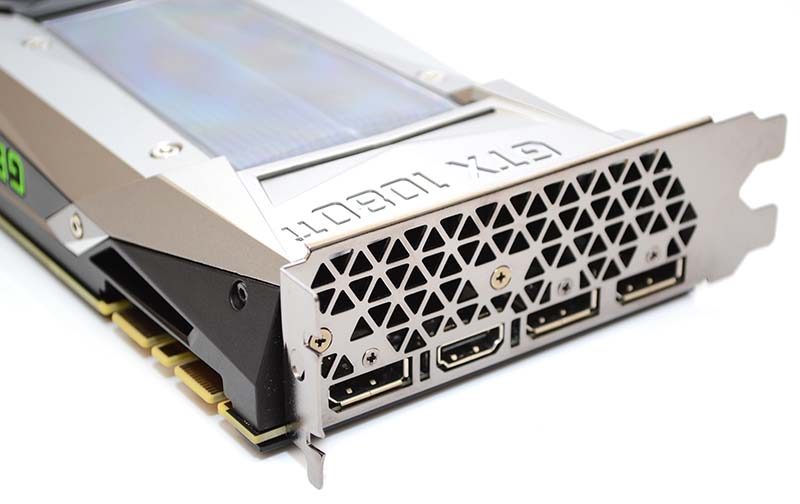
On the bottom of the card, a full cover backplate, which has a subtle patterned design and improved the overall cooling capabilities of the card, and improves the durability, so it shouldn’t droop down at the back and lead to “GPU sag”
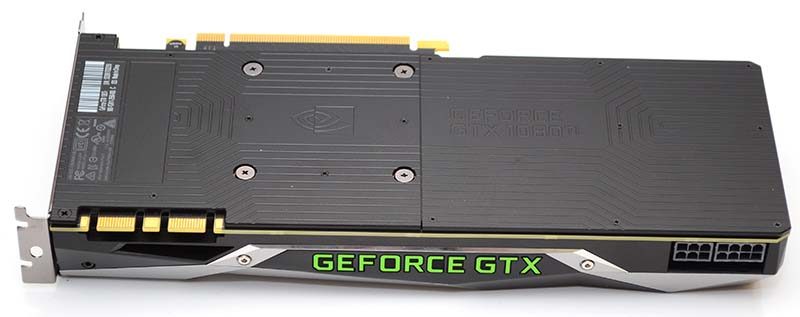
Overall, this is a very nice looking card, but with that in mind, let’s get it plugged into our test bench and get to the good stuff; performance!

Testing & Methodology
Here is the test system used for all graphics card reviews and game performance analysis:
Hardware
- Motherboard – Gigabyte X99-Gaming G1 WiFi LGA 2011-3
- Processor – Intel Core i7 5820K at Stock 3.3GHz
- RAM – 16GB (4 X 4GB) Crucial Ballistix Sport DDR4 2400MHz
- CPU Cooler – Thermaltake Water 3.0 with Gelid GC-Extreme
- Power Supply – BeQuiet Dark Power Pro 11 1200W
- Main Storage Drive – Crucial M550 512GB
- Chassis – Lian Li T80 Test Bench
- Displays – Iiyama G-Master GB2888UHSU 4K Monitor
- Operating System – Windows 10 Pro 64-Bit
Additional Hardware
- “Killawatt” style electricity usage meter wall plug
- Precision Gold N05CC Decibel meter
Games
Throughout the testing procedure, we always use demanding presets which stress graphics cards to their absolute limits. However, in the interest of fairness, any technology which favours either AMD or NVIDIA is disabled. More specifically, this refers to PhysX, Hairworks and more. Additionally, we also disable all forms of AA to gauge performance levels which aren’t impacted by sophisticated AA. Theoretically, we could have employed FXAA because it only has a minor impact on the frame-rate, but many users strongly dislike the hazy image this causes. Apart from the details mentioned above, all settings remain at the maximum values.
Some benchmarks may feature more cards, this is due to some tests being older or newer than others, and being used in other game specific feature tests we have conducted, so you’ll find all relevant cards included in each chart as we add or remove new and old tests.
Selecting strenuous presets especially at higher resolutions can cause hitching and other performance problems on graphics cards with lower amounts of video memory. For example, Rise of the Tomb Raider’s Very High textures requires 4GB of RAM to maintain a smooth frame-rate. In theory, we could run the benchmarks at the High setting, but this defeats the purpose of high-end graphics cards which are designed to cope with the absolute best graphics on the market. Furthermore, the notion of enthusiast cards sporting less than 4GB memory has become less of an issue. Of course, whenever we’re tackling more affordable GPUs, the settings will be altered accordingly and detailed for clarity.
Software
- Deus Ex: Mankind Divided (DirectX 12)
- Doom (Vulkan)
- Far Cry Primal (DirectX 11)
- Hitman (DirectX 12)
- Rise of the Tomb Raider (DirectX 12)
- 3DMark
- Unigine Valley
- CPU-ID HWMonitor
- TechPowerUp GPU-Z
Noise
Everyone has their own reasonable noise level when it comes to comes to components on a computer. Some can handle all fans at 100% load to keep temperatures down; some want an entirely silent computer. To accurately gauge the noise output of a graphics card, we position a Precision Gold N05CC Decibel meter from two metres away from our open air test bench and take an average reading.
Power Consumption
With electricity becoming increasingly expensive across most parts of the world the need for computer components to become power efficient has never been more relevant. Graphics cards are often the most power-hungry components of a desktop system so having an efficient graphics card is crucial to keeping power bills under control. Power is tied to heat, so lower power consumption means a graphics card is likely to run slightly cooler and put out less heat into your system meaning your other components will run cooler with improved longevity. AMD and NVIDIA have both made power consumption an integral part of the way graphics cards dynamically overclock, so the need for graphics card vendors to use efficient VRM and PCB designs is becoming essential to maximise performance. We take power readings after 5 minutes of two different load scenarios: desktop idle and Unigine Valley for load.
Temperatures
The cooling solution which graphics card vendors choose to implement is one of the main differences that consumers have to contend with when selecting a graphics cards. Apart from their acoustic properties, the thermal properties of graphics card coolers are critical. Lower temperatures are always better, and with AMD and NVIDIA opting to use dynamic overclocking algorithms that take temperature into account, it is important that graphics card vendors use high-performance cooling solutions to maximise performance. The era of graphics cards reaching critical temperatures are now in the past, but the importance of low temperatures remains. Lower temperatures mean better stability, longer component longevity and lower fan speeds. We take temperature readings after 5 minutes of two different load scenarios: desktop idle and Unigine Valley for load. We always record actual temperatures and make any adjustments for changes in the thermal testing environment.
3D Mark
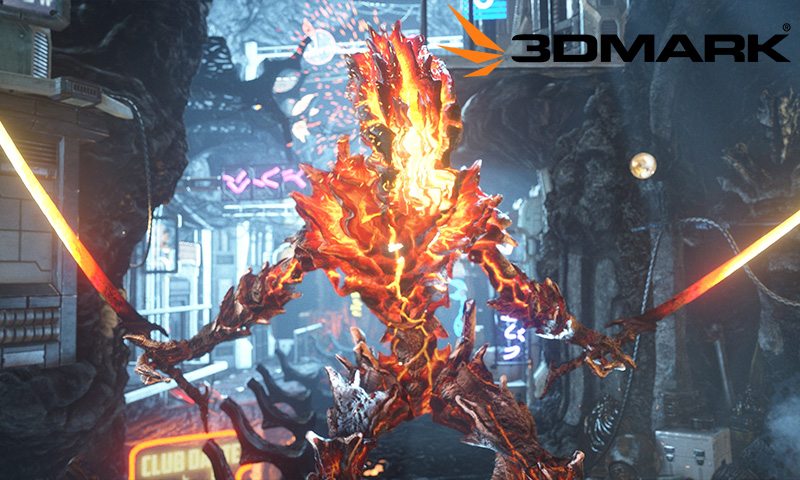
The 1080 Ti is the new flagship card from Nvidia and poised to be the fastest consumer GPU on the market. Straight away we can see it at the top of our charts in every single test. What’s impressive is how much of a lead it has on aftermarket overclocked GTX 1080’s, it’s one of the biggest improvements on our charts, ever, pushing another 10% past the Palit GTX 1080.


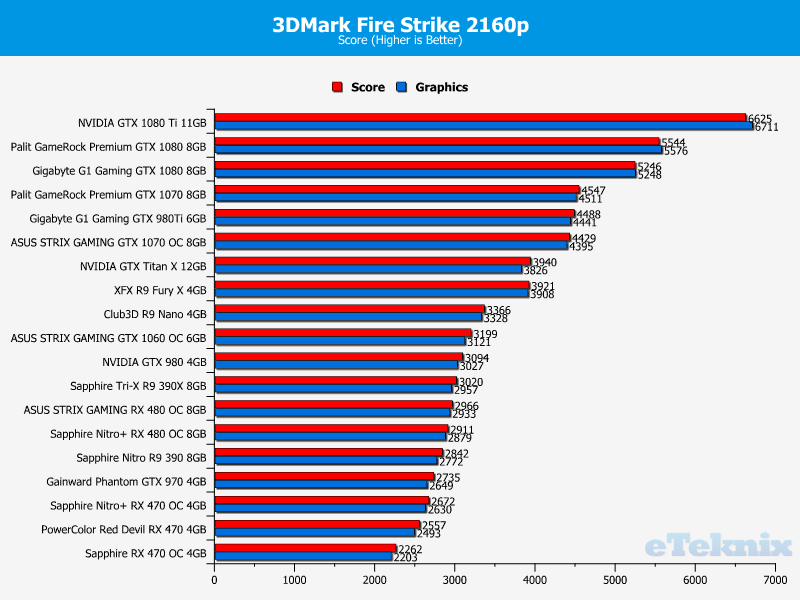
Unfortunately, no GTX 1080 ran this test at eTeknix HQ yet, but it’s a real test on the GTX 980, showing over 70% improvement from generation to generation, which is very impressive. Synthetic benchmarks are just that, however, so let’s move on and fire up some demanding PC gamers to see the real-world performance.
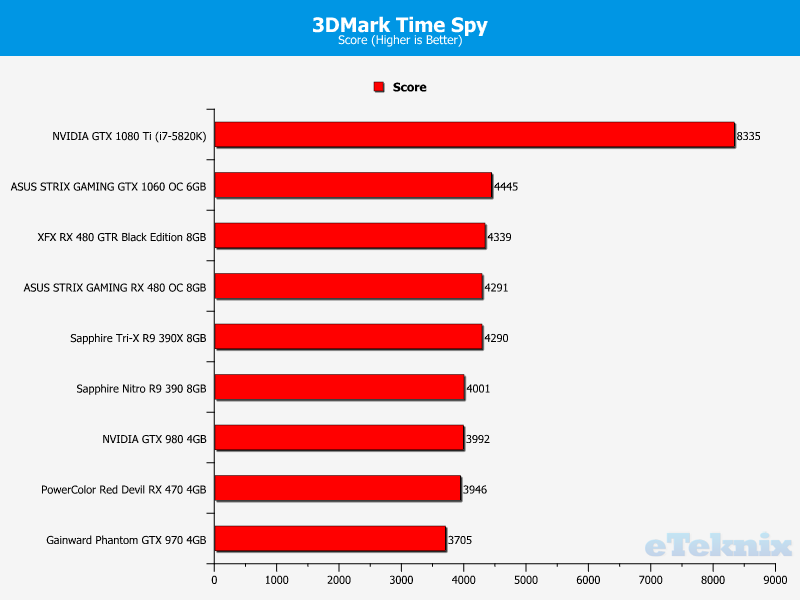
Deus Ex: Mankind Divided

Again, we see exceptional results. The card blasted past 60FPS at 1080P, holding pretty steady at 1440P, and while it takes a beating at 4K, it wouldn’t take much tweaking to the settings to get better performance, as we max everything maxed out and Deus Ex isn’t the best-optimised game in the world at higher settings.
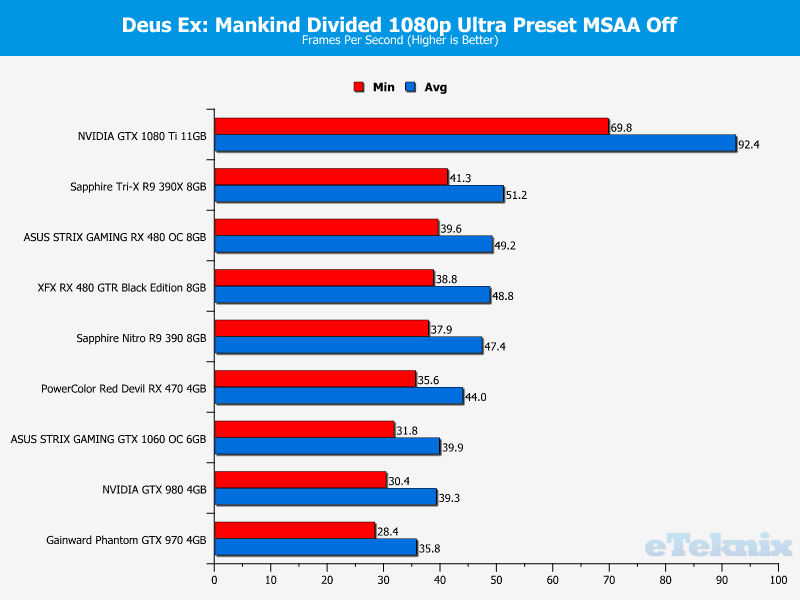


Doom
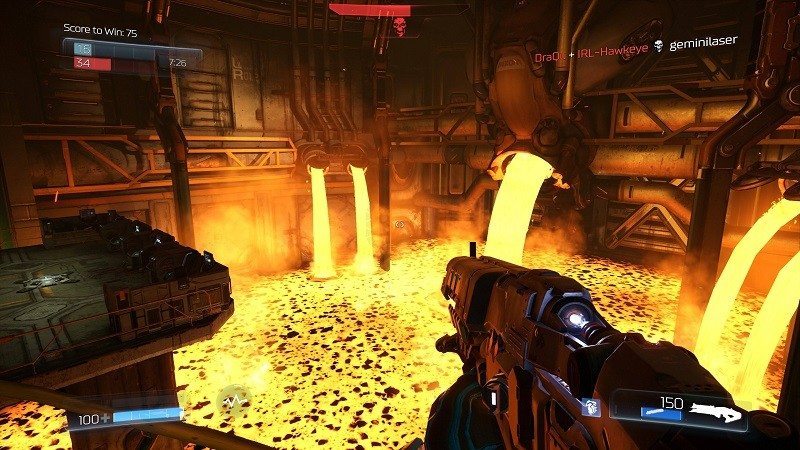
Today I found out that Doom has a frame rate cap, and the GTX 1080 Ti held right at that maximum of 200 without fault at 1080P, giving us incredibly smooth gameplay. Bump the resolution up, and it’s still far north of 100fps, which is good news for those with high frame rate displays. Even at 4K, the game didn’t drop below 70FPS, averaged 95FPS, and we saw it hitting 150+ from time to time too.
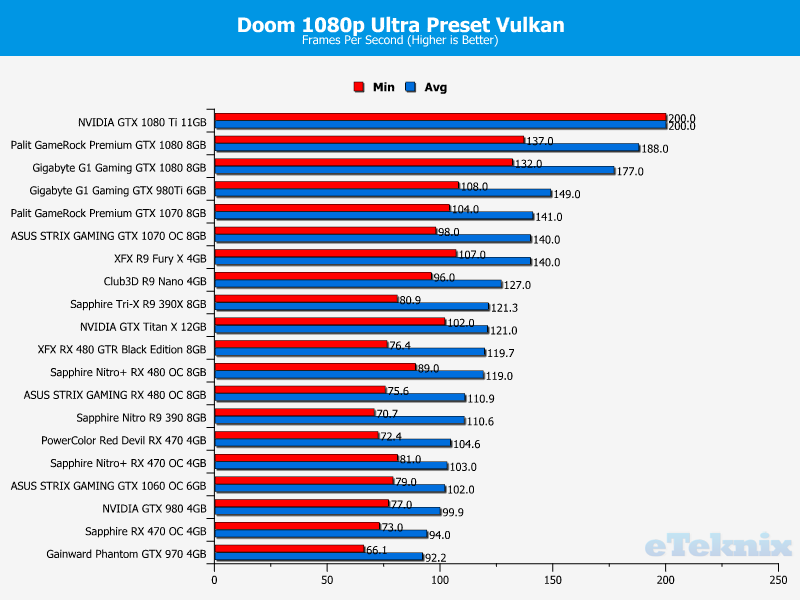


Far Cry Primal

At 1080P, the gains from the GTX 1080 Ti aren’t that huge but move up to 1440P, and we saw the average rocket past 100 FPS, very impressive, and that continued through to the 4K test. It’s clear that the new card brings the benefits to those wanting to game at 2K/4K resolutions!



Hitman

Hitman is very demanding, but the GTX 1080 Ti makes easy work of it clocking our best score yet and creeping ahead of the Gigabyte G1 Gaming GTX 1080. The real surprising result is at 4K, where the new card pulls a huge lead on the last generation, once again showing how this card has the edge for those pushing high resolutions.
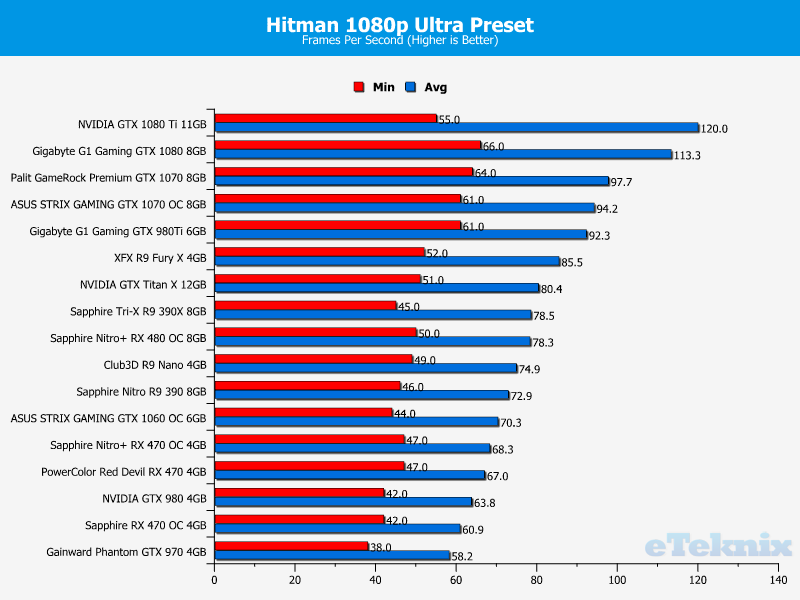
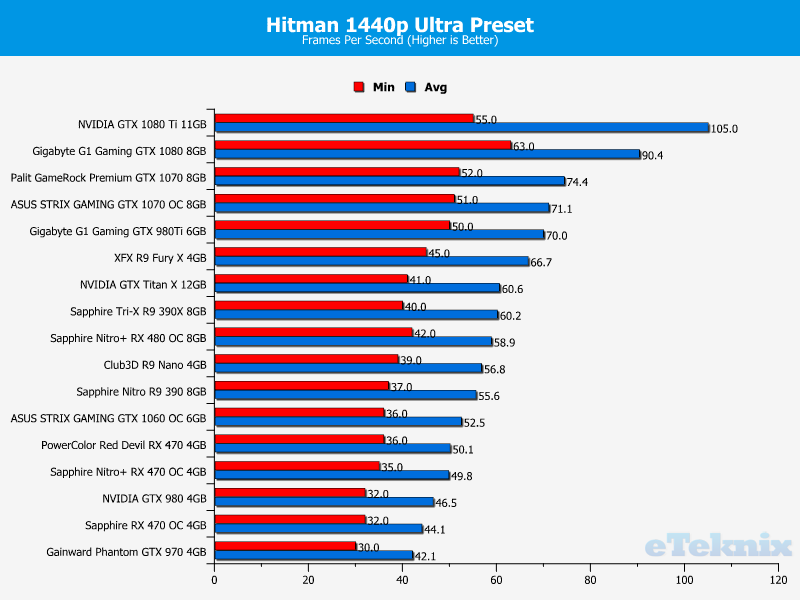

Rise of the Tomb Raider

If you’re a fan of Tomb Raider, then you’re going to be a fan of this GPU. Once again, we didn’t see a huge benefit to this over the last generation at 1080P, but once we moved to 1440P and 4K resolutions, the GTX 1080 Ti with its increased performance and 11GB of memory started to show their worth, giving us some robust figures.


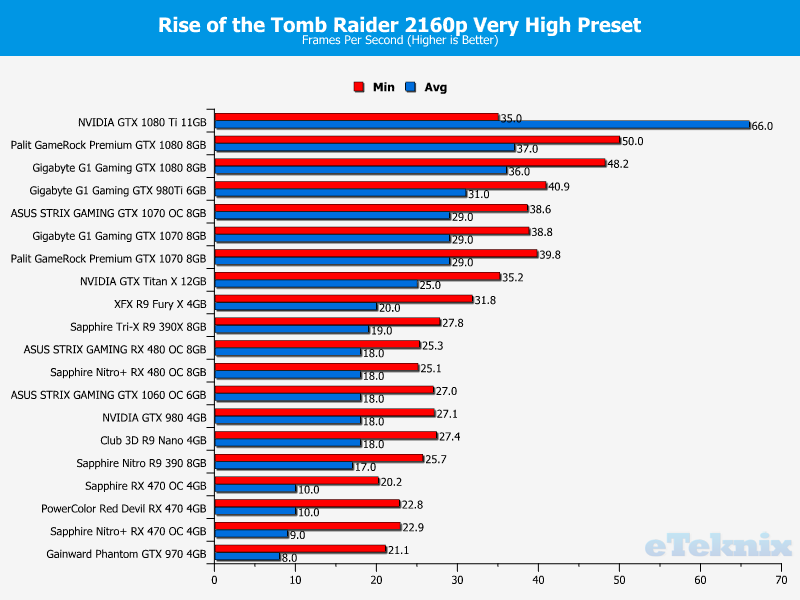
Overclocking and Overclocked Performance
We’ve heard some inspiring stories of the GTX 1080 Ti’s overclocking abilities, and while we did have some success, it’s not as impressive as we hoped, as that stock cooler does seem to be holding things back a bit. We’re certain the card can do more, but it power throttles to keep the hardware safe above 82c, although we’re certain it can handle the clocks, we did have to dial things back for the optimal performance.
I managed to get an extra +173MHz from the GPU core, and the memory clock took another 600Mhz without breaking much of a sweat. This meant that we ended up with the core clocked at 1654Mhz, and a boost clock of 1755Mhz, and a memory clock of 6106Mhz effective, not bad given that any gains here are a free upgrade.
Deux Ex: Mankind Divided
Overclocking the card took some already impressive numbers and turned them into gaming gold. While not the biggest overclock ever, an extra 10FPS is not to be sniffed at.

Far Cry Primal
Again, we saw a 7FPS boost in Far Cry, not a huge gain, but a welcome one regardless. However, we want to see this chipset with a bigger cooler, so that we can take that GPU Core much higher, and we’re confident it’ll do it too.

Noise, Power Consumption and Temperatures
Noise
This is a blower type card, and they’re typically known to be louder than most aftermarket coolers. However, at 48dBa, it’s far from the loudest card we’ve tested, scoring a result that is on par with that of the NVIDIA GTX Titan X 12GB, although that should come as no surprise given the similar design.
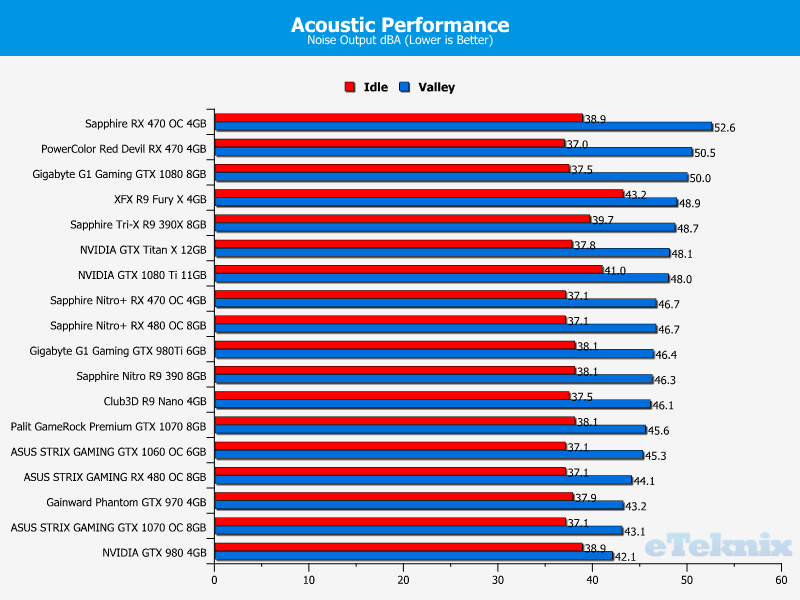
Power Consumption
The 1080 Ti may be efficient, but it is also very powerful, and while we’ve seen that it delivers a lot of performance, it does sip a lot of juice too. I’d be more concerned if all that wattage weren’t giving up lots of FPS, but we know the power is going to good use.

Temperatures
The card does get pretty hot, although still runs a little cooler compared to the Titan X, showing a nice improvement on generations as this card is faster and cooler, which also maintaining a comparable noise rating from the fan, which is pretty impressive.
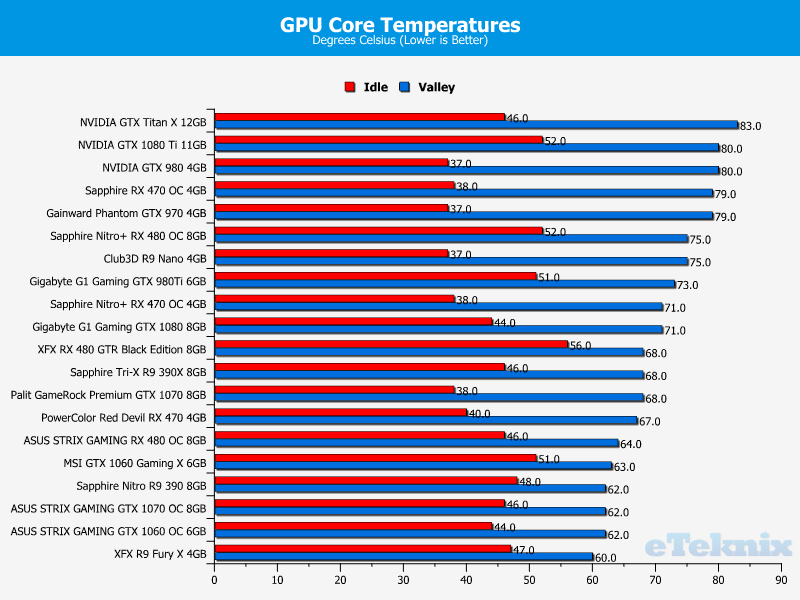
Final Thoughts
Price
This is the flagship graphics card from Nvidia and right now, the fastest card on the market isn’t going to be cheap. It clocks in at £699.00 directly from Nvidia, which is comparable to the launch price of the GTX 1080, which has since been lowered to £545. That makes the Ti about 25% more expensive, and for the most part, we saw similar or greater % improvements in performance too.
Overview
This graphics card is freaking amazing, what else is there to say beyond that? A lot! Nvidia is already a market leader in terms of sales, and they’ve certainly been in the lead a lot recently regarding performance. So, for them to come out with a card that gives such an impressive performance boost over their last flagship card, the GTX 1080, is crazy, but they’ve done it.
I own the GTX 1080 personally, and it’s fantastic for gaming at 4K resolutions, high-frame rate gameplay, and all the other usual joys of high-end PC gaming, but dialling games up to ultra settings can still cause dips below 60FPS. The Ti gives a strong boost to overall performance, often removing the need to compromise on visual quality to get to your target frame rate.
The stock performance was impressive, and we even managed a modest overclock that gave us an extra 10% improvement in performance. However, we’re confident that this card has more to offer if only we could keep it from thermal throttling. It won’t be long before 3rd-party cards hit the market, then we’ll see how hard we can actually clock this new and improved GPU core. Of course, if you’re going for custom loop cooling, this founders edition does have an easily removable cooler and may be cheaper for those who want to overclock the card themselves.
The price is pretty steep, but it’s around what we expected compared to the last few premium cards from Nvidia. Keep in mind, that this is faster than cards such as the Titan X, which was much more expensive at launch, although not quite the same class of gaming card as the 1xxx series, even if it is based on similar hardware.
The design is great, the build quality is rock solid, the performance is the best you can get right now, and when it comes to high-resolution gaming, the card loves to stretch its legs when faced with a challenging game, no doubt reaping the benefits of having 11GB of blazing fast memory.
“The Nvidia GeForce GTX 1080 Ti sets a new standard for high-resolution and high-framerate gaming, delivering a huge performance increase over the GTX 1080 that makes easy work of any and all PC games!”
Pros
- Exceptional performance
- Perfect for 1440/2160p gaming
- 11GB of GDDR5X memory
- 10% performance boost from overclocking
- Faster and cooler without increasing acoustic levels
- Incredible gaming performance
Cons
- Stock cooler is holding back the overclocking capabilities
Neutral
- It’s a little out of many peoples price range, but you do get what you pay for

Nvidia GeForce GTX 1080 Ti 11GB Graphics Card Review



















